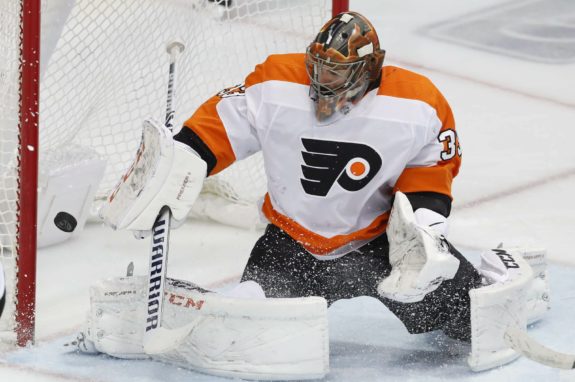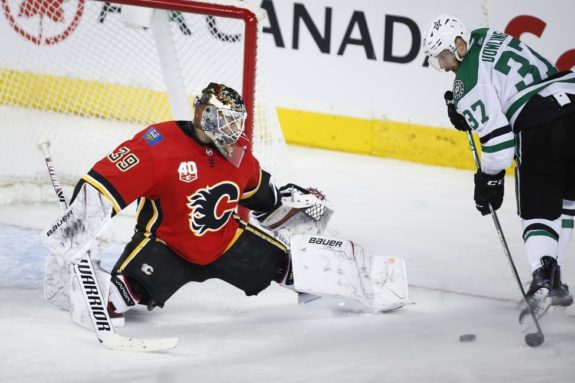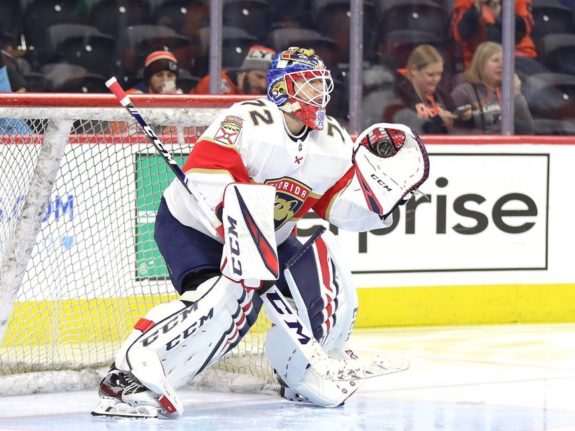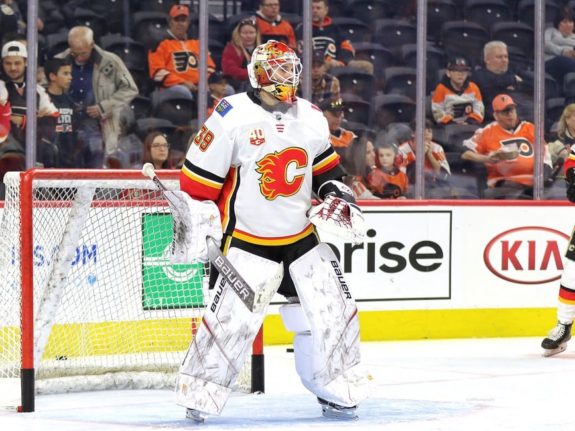Elite goaltending is an essential component of a Stanley Cup-winning formula. When a netminder transforms into an acrobatic, rubber-deflecting brick wall during the dog days of a best-of-seven series, the storyline ascends into hockey folklore. But of course, in typical offseason panicky fashion, some NHL general managers, either in a bout of witlessness or salary cap flexing, inevitably engage in ill-fated free agent signing that conflates clutch goaltending with dumping wheelbarrows of cash at the position in hopes that the player’s peak will sustain itself throughout the deal.
Related: Flames’ Best & Worst Drafts in Team History
Cam Talbot’s contract is up, and the Calgary Flames have $16 million in cap room. General manager Jim Treliving has a plethora of goaltending options available; as these factors swirl distressingly close together, I worry that they’ll be woven into a hamfisted Paul Holmgren/Ilya Bryzgalov maneuver. The free-agent goalie landscape is a mix of adequate and unsettling, and it’s worth considering whether any are worth moving on from Talbot at a price tag north of $4-5 million.
| Goaltender | Team | 2019-20 Salary | Record | GAA | Save% |
| Braden Holtby | Washington | $6.1 million | 25-14-6 | 3.11 | .897 |
| Corey Crawford | Chicago | $6 million | 16-20-3 | 2.77 | .917 |
| Robin Lehner | Vegas | $5 million | 19-10-5 | 2.89 | .920 |
| Craig Anderson | Ottawa | $4.75 million | 11-17-2 | 3.25 | .902 |
| Jakob Markstrom | Vancouver | $3.66 million | 23-16-4 | 2.75 | .918 |
| Anton Khudobin | Dallas | $2.5 million | 16-8-4 | 2.22 | .930 |
| Mike Smith | Edmonton | $2 million | 19-12-6 | 2.95 | .902 |
Last summer, the Flames brought in a seemingly wilted 33-year-old Talbot on the heels of a 10-15-3 record and a .893 save percentage (SV%). He was hastily excised from the Edmonton Oilers last year and shipped to the Philadelphia Flyers where he didn’t fare much better. Taking a flier on a once-capable netminder was one of those unsexy moves that doesn’t generate many headlines, but pans out when you least expect it and most need it.

Talbot was the guy and the opposite, spending seasons as one of the better and one of the worst starting goaltenders in the NHL. After two straight seasons of getting lit up, the humpbacked arc of his career continued its grim slide during his first two months with the Flames when he earned one victory. From December on, though, he surged to an 11-5-1 record and a .927 save percentage (SV%) with two shutouts — winning four of five outings before the NHL’s abrupt hiatus.
During the bubble battles, when everything else about the Flames was constipated, he was brilliant. Heading into that fateful Game 6, appropriately described as the Canadian Chernobyl, the resurgent goaltender was sporting a 2.17 goals-against average (GAA) and a .934 SV% in nine starts, along with two shutouts. He was chased after surrendering three goals on eight shots, and Flames head coach Geoff Ward dispatched backup David Rittich for mop-up duty. He was similarly hapless in backstopping a team that played like a bunch of turnstiles with dull outside edges.

What happened in that gruesome, one-way barn-burner is the stuff that dampens a season and prompts a flummoxed general manager to mismanage an otherwise playoff-caliber roster. With the Detroit Red Wings, personnel wizard Ken Holland warned against overpaying goalies, as he preferred to generously compensate elite scorers and top-pairing defensemen, who offer far more stable and predictable production year after year.
A Brief History of Big-Contract Goalies
So the offseason being the offseason and fans being fans, many summertime transactions have a specifically anxious or whiny gripe attached to it, but shelling out gobs of cash for a wildly unpredictable position should, at least among us Armchair Moneyball Nerds, warrant some deep skepticism.
Over the last three years, Carey Price, Sergei Bobrovsky, and Andrei Vasilevskiy have parlayed awe-inspiring performances into lucrative long-term deals hovering around $10 million in annual salary. At the time, these top-dollar deals seemed like no-brainers.
For Price, the Canadiens signed him to an eight-year, $84 million pact in 2017, and this past regular season, he registered an uninspiring .906 SV% (33rd in the league) and a minus-8.6 goals saved above expected (49th in the league). He summoned his 2015 self for the playoffs, but his heroic efforts weren’t enough to propel his team past the Flyers in the quarterfinals.
Bobrovsky’s first year of a seven-year, $70 million contract was similarly distasteful; with an .896 SV%, he wasn’t as much of a sieve as he was the Oprah of padding other team’s stat sheets. Outlier Vezina-worthy season notwithstanding, Vasilevskiy has posted a below-average goals saved above expected three of his four years as a starter, and his projected 2020-21 salary of $12 million will be tied for fifth-most among NHL players.

It is also incomprehensibly difficult to find an egregiously bad goalie these days; when such an unfortunate happenstance befalls a team, it is likely more of a product of a twisted, perverse monkeys/typewriter/Shakespeare scenario than anything more damning. In the 2019-20 regular season, 35 goalies (minimum of 100 shots faced) mustered save percentages of .910 or better. The difference between the 50 highest paid goaltenders and the 50 lowest paid ones is roughly 5.2 goals saved above expected per 60 starts on average—or about one win and a difference of $7 million in salary.
There are plenty of reasons to be confident with most netminders, but it’s incredibly difficult to be very confident in any puck stopper living up to a premium price point on a steady basis. The problem isn’t the individual goalies—it’s the position itself. Each big-budget tendy has played like big-budget tendy throughout their careers, and are capable of looking strikingly like the part on any given night; the consistency at which they can soar at their apex, though, appears to be frustratingly and vexingly random and scattershot.
Why the Flames Should Bring Talbot Back
Multiple reports have suggested that the Flames and Talbot have a mutual interest in another go-around, provided they are aligned in contractual price and term, and as long as the netminder believes he has a “fair chance off the bat” to earn the starting gig.

From a character standpoint, the Flames’s biggest weakness is delivering in the clutch, or at least not monumentally collapsing, and Talbot brings a solid resume of competent playoff performance.
In addition to his stellar bubble play, when he was with the Edmonton Oilers in 2017, the Anaheim Ducks pushed them to the brink of elimination after a Game 5 double-overtime win, so Talbot strapped on his pads for a do-or-die Game 6 and stopped 34-of-35 shots as the Oilers cruised to a 7-1 victory. It has been 16 years since a Flames goaltender posted multiple shutouts in a playoff run, and Talbot delivered the best postseason performance for this franchise since Mikka Kiprusoff’s legendary 2004 stint.
Even with a skittish, jittery end to his 2019-20 campaign, David Rittich has proven himself to be a capable goalie, and with Talbot, should form a platoon that the Flames can be confident in. Keeping these two around as a reasonably priced Batman-and-Robin duo could keep both of them fresh throughout the year and allows the Flames to play the hot hand as the situation dictates, a strategy that has worked out for the Vegas Knights thus far in the bubble playoffs, and for the Penguins and Blues in their Stanley Cup runs. With the recent success of goalie tandems, it’s not out of the question to think this could be a trend going forward for many NHL teams.
Related: Jarome Iginla’s 5 Greatest Highlights
Given the Flames’s underwhelming and listless season finale, bolstering the middle-six and replenishing a defensive corps that projects to have five UFAs appears to be of higher priority than pursuing a high-priced netminder that could devour 8-10 percent of Calgary’s cap space. This team is a few pieces away from being a top-tier contender, and it starts with locking down Talbot at what will likely be an annual salary of $4-5 million at a two-three-year term, giving them the room to address more crucial roster needs.